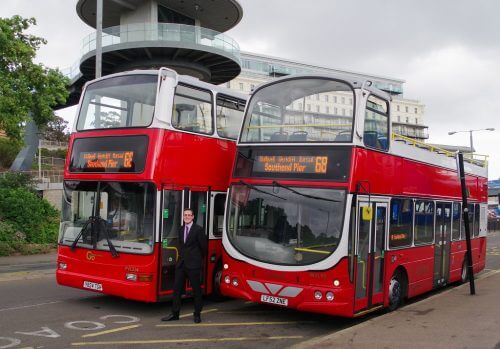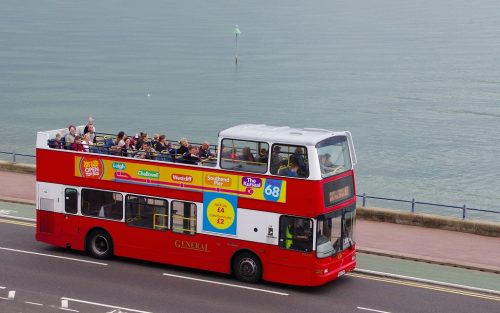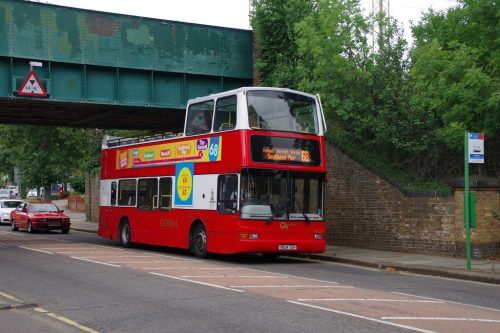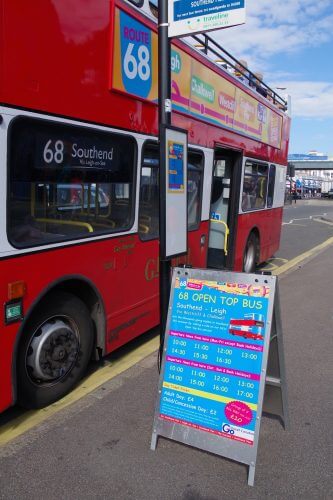
John G. Lidstone explains the work behind the Go-Ahead London Volvo B7TL open-topper service 68 that started operating in Southend-on-Sea in July this year
The summer season of 2017 has seen a renaissance in a number of areas of the country for traditional style open-top bus services. This is an interesting development, given that the sightseeing tour has had the edge in making a robust return in recent years, with the ability of such operations to coin a premium fare.
One such operation that has been causing quite a stir – in a good way – amongst the local public is at Southend-on-Sea, a traditional seaside resort often dubbed ‘London’s playground’ and where open-top services ran for decades after the war but faded away completely over the last 10 years.
Southend’s former municipal airport is now retitled ‘London Southend’ under Stobart Group ownership and so might the new open-top operation re-dubbed ‘London Southend seafront service 68’, for this has been brought into being not by a local operator in the South Essex area, but by Go-Ahead London Commercial.[wlm_nonmember][…]
What you get with a subscription
- Operator & Supplier Profiles
- Face-to-Face Interviews
- Lastest News
- Test Drives and Reviews
- Legal Updates
- Route Focus
- Industry Insider Opinions
- Passenger Perspective
- Vehicle Launches
- and much more!
Thomas Drake
Go-Ahead London already touched the Thames Estuary resort by means of the high summer school holiday double-decker seaside extensions to its Romford shopper service 575 from Harlow.
All the more remarkable perhaps is that the operation was entirely the brainchild of young Go-Ahead London Commercial rail replacement Schedule Compiler Thomas Drake, who, at just 22, went out on a limb to suggest a Southend seafront service, recognising a commercial opportunity that was efficiently exploitable to employ an open-topper on a daily basis during the summer school holidays. More of this in a moment!
It’s perhaps less fashionable these days to suggest that more mature-minded young transport enthusiasts can form a valuable recruiting pool for bus operators but, in Thomas’ case, this is demonstrably true.
Thomas’ interest led him to a part-time appointment with a small independent operator, which introduced him to his forte of schedule compiling, as well as grounding him with useful experience of publicity and customer relations.
Staying in the private sector, he then gained operational experience at the sharp end with enterprising Ensignbus, where he acted as a rail replacement pilot and, on several occasions, as an ‘on the spot’ rail replacement controller.
Responding to an advert for a trainee schedule compiler, Thomas’ next career step took him to a full-time position with Go-Ahead London Commercial in early 2016.
Interestingly, he came second for the position (as he hadn’t had TfL experience the chosen candidate could offer), but his commercial acumen was spotted and, to Go-Ahead’s credit, he was offered a bespoke position to make good use of his talents and experience.

Here too, early on, his remit was expanded from rail replacement work to the much broader task of becoming an assistant to the Commercial Planning Manager.
By this time, echoing its successful municipal past, Thomas had drafted route, timetable and operational duties for his Southend open-top service idea and took time to liaise with me to fine-tune some aspects of this, recognising my operational experience dating back to 1975.
That a London operator was actively planning a remote open-top operation 35 miles from the capital was quite a surprise, given the abandonment of such services by major operators 20 years ago and progressively weaker private sector operations also having fizzled out a decade ago in anything but a blaze of glory. The last such one-bus operation abruptly ended without prior warning owing to a defective vehicle in mid-August 2012.
The route
Thomas’s plan was effectively simple: to seek out the best elements of those earlier years’ success and put in place a simple, regular service, avoiding double-runs to and from the town’s bus station, which had been an unappealing aspect of the recent past.
The period of operation was dictated in part by Go-Ahead London’s commitment to providing its private charter and special events fleet to cater for special event shuttle services, such as to Wimbledon tennis and the Chelsea Flower Show, as well as excursions and charters to and from events such as Farnborough Air Show and the Epsom Derby race meeting.
After a little quite understandable early skepticism, Thomas continued to develop his idea, including draft roadside publicity such that Go-Ahead London’s Commercial Manager Colin Farrant took up the idea and gave Thomas the nod to actively pursue his concept and make it happen.
Following further preparations, a successful risk assessment trial was operated over the route on an unusually grey, cold and drizzly May day, which showed Thomas’ route and timings to be eminently sensible. As a one-bus operation, he felt it key to operate over the core passenger catchment area between Leigh-on-Sea to the west of Southend and the central Southend seafront area.
Thomas also recognised the need to provide as frequent a headway as possible and the Leigh-Southend service – equivalent to the former municipal early/late season service (which also did not go further east to the North Sea-facing East Beach at Shoeburyness) allowed an hourly frequency to be offered.
Wisely, given more haphazard traffic conditions on sunny summer weekends, his service built in a stand time – the most effective advertising of all – at the westbound stop at Southend Pier, traditionally the busiest stop on the route and the one most likely to capture the attention of visitors and passers-by.
Several route and terminal/turn around points were considered – such as the former municipal tramway eastern terminus at Thorpe Bay Corner, whilst two turn-round route options were put on the table, to deal with occasional weekend traffic gridlock. Southend’s iconic Kursaal was settled upon as the optimum eastern turn point.
Also under consideration was the routing of a loop around Leigh-on-Sea, both to serve the bustling town centre, as route 68 always did, but whether to also take the bus into Old Leigh itself (quickly ruled out) or as close as possible to the fishing village of Old Leigh to the south as the ‘tour’ services more recently had done. The loop idea worked, to enable the c2c railway station at Leigh to be served.

Preparations
Planning stage risk assessments showed up some concerns, chiefly about a low bridge enroute at Chalkwell, but this was swiftly dispatched by investigation and route trials.
Foliage from low trees, although ironically most were on roads already served by double-deckers, was shown up in route trials and Southend Council proved a helpful ally, calling in its local arborists to trim this back. Word quickly spread around the corridors of power locally, leading to an active interest by the Leader of the Council, Cllr John Lamb, and many of his colleagues, spotting the return of an open-top service as a true asset for the town.
So, on top of ‘the day job’ of rail replacement work, Thomas found himself at centre stage to deal with every aspect of bringing his brainchild into commercial reality, from 17 iterations of timetable leaflet design through to a personal redesign of overly-complex on-bus route-branding panels, to dealing with a myriad of council comments by phone and email and making up a side ‘blind’ for the bus itself.
The traditional start date of Southend’s seafront service, late May Bank Holiday, could not be entertained for reasons highlighted, so a start date to offer the service for the high summer school break was set for July 24, which followed an unusually long period of superbly settled summer sunshine, for which Southend is renowned, as the driest resort in the UK.
Following the route risk assessment runs, detailed drivers’ route instructions, highlighting hazards (such as the need to pass with extreme caution beneath Chalkwell railway bridge) were prepared and given to the small panel of seven selected drivers who ventured east for a route learning day to gain hands-on experience.
The service is operated daily from Northumberland Park garage in London, the bus making its way out of service each way. Meal breaks are covered by a 30minute drop-back after lunch in the timetable added to the Pier stand time, whereas at weekends, timings are constant with the 575 driver covering a meal relief rounder.
Thomas had noted that another seaside resort’s open-top sightseeing tour was promoted at its start point with a traditional ‘A-board’ and so he had one prepared, using the more detailed route map he’d simplified earlier for on-bus advertising.
Thomas’ thinking was spot on, for although the local council fitted all bus stops with timetable panels for the service, the A-board captured the interest of passers-by and visitors strolling along (even in the rain!).
An eye-catching timetable leaflet was drawn up and simple, cheap and attractive fares to make the product as appealing as possible.
It’s fair to say Thomas is something of a perfectionist and that’s no bad thing when it is positively channeled into a close eye on detail that matters – as he told me: “a bus company is not just a business; you’re in the public eye. You’ll never make money unless you please the customer.” To Thomas, that means getting the detail right, such as simplicity of message.
He explained, referring to bus-side advert route branding boards: “that poster isn’t in front of you: it’s moving. You have seven seconds to read it.” He rejected a more detailed geographic design for the route-specific side adverts, simplifying the design and the message to a diagrammatic representation of the route on both sides and promotion of the very reasonable £4 adult day rover and £2 child/concession rover fares, which Thomas could read in that seven second window.
The local Tourist Information Centre (handily close-by at the Pier entrance) as well as hotels and local businesses, via an agency, have been targeted as key to getting the message across with an initial print run of 10,000 timetable leaflets (5,000 distributed and 5,000 in on-bus holders).
Tom also took trouble to organize a press launch event, to which key local dignitaries were invited, as well as local media. The local radio station even ran a Facebook Live, event from the bus, its upper deck comfortably populated with invited guests to sample the route. Typical of his eye for detail, on the previous evening, Tom could be found at Northumberland Park garage, cleaning the bus windows, inserting a ‘fixed’ side indicator display to supplement the LED indicator display he programmed himself, having had no previous experience of such.
Advance publicity was good, drawing in the local press and its online media opportunities as well as the local radio station – so exposure was given via Facebook, Facebook live, Instagram and Twitter feeds – none of which any previous seafront service had exploited.
Initial operation

After so much planning and detailed work, the first day of new service 68 dawned grey and cold with a glowering sky – wouldn’t you just know it? Right on the dot of 1000hrs, as the wheels of carefully prepared red, white and grey ‘General’ liveried open-top Volvo B7TL PVL224 started rolling – a heavy, insistent drizzle started to fall.
Now unlike many traditional seaside resort’s open-toppers, Southend’s seafront buses were renowned for decades for carrying on, come rain or shine, often with an umbrella or two huddled behind the upper deck front windshield. So an expectation by some of a disappointing empty first trip was happily dashed, with a good few brave souls sheltering under the roofed forward section, or securely wrapped in cagoules or sheltering under umbrellas further back.
Cannily, former Hong Kong Citybus founder and CEO Lyndon Rees commented that under Chinese Feng Shui, a light drizzle on a new enterprise suggests that it will ‘bring money’ and he assured me that this is rarely wrong. With an unsettled forecast for the fortnight ahead, this seemed as welcome as it was possibly far-fetched. But how right he was!
As the first bus appeared through driving rain, headlights shining brightly, with a determined cluster of passengers on the upper deck (to the surprise of the driver), some saw this as a good portent whilst others an indication merely of a ‘first day’ bubble which would soon burst. But it didn’t.
Indeed, in the first week, on one day, passengers were turned away at one point owing to the bus being full to capacity, which was almost astounding.
Come rain or shine (or mostly just grey days), loadings steadily built up and have sustained, a good part of this being due to families choosing to ride the service several times a week, either for children to enjoy or, as one family of 13 told me “it’s cheaper than parking our cars at Old Leigh.” That family group was making their 8th trip on the service that day.
Word soon spread around the town, with a remarkable cross section of non-bus-minded folk buzzing with excitement – such as youngsters trying a Southend open-topper for the first time, visitors trying at as ‘something new to do’ or older folks just celebrating the welcome return of open-top 68s again.
Thomas’ thinking was absolutely right.
With both on-bus and roadside advertising getting the message across as effectively as online media, almost full upper deck loads were being carried from day two, bettering loads for equivalent operations in unsettled weather of 40 years previously.
Some passengers, like pensioner Doreen Gregory, vowed to use the service every day as they were so pleased by its return. I rode with her the other day and she’s kept her vow! Repeat traffic is key to success; along with completely new passenger growth without abstracting from any other route, as 68 is away from other services except between just Leigh and Chalkwell.

Exceeding expectations
From his having a concern that all would go well for his first ever press launch (which was a huge success) just three weeks later, Thomas has ended up being congratulated for his initiative by Go-Ahead’s Head Office.
Passenger loadings have far exceeded expectations and have grown to the point that by mid-August, full standing loads were being regularly carried in the afternoons, leading thoughts to duplication for settled sunny days, but with an operational base more than 40 miles away, that’s not an easy matter.
All this amply demonstrates that a youngster’s commercial hunch could be right ‘on the money’ which is very encouraging. He’s proven – after established operators gave up – that there was still a latent demand both for a service along Southend’s western esplanades and also the link that such a service would bring between Leigh-on-Sea and seafront attractions of Westcliff and Southend.
Sustained healthy loadings have been encouraged by a very professional on-street operation, with timings well kept and the bus where it should be each day. Feedback has been universally strong and positive, showing Go-Ahead’s acumen to provide the right product at exactly the right time, in the right way and at the right price.[/wlm_ismember]


